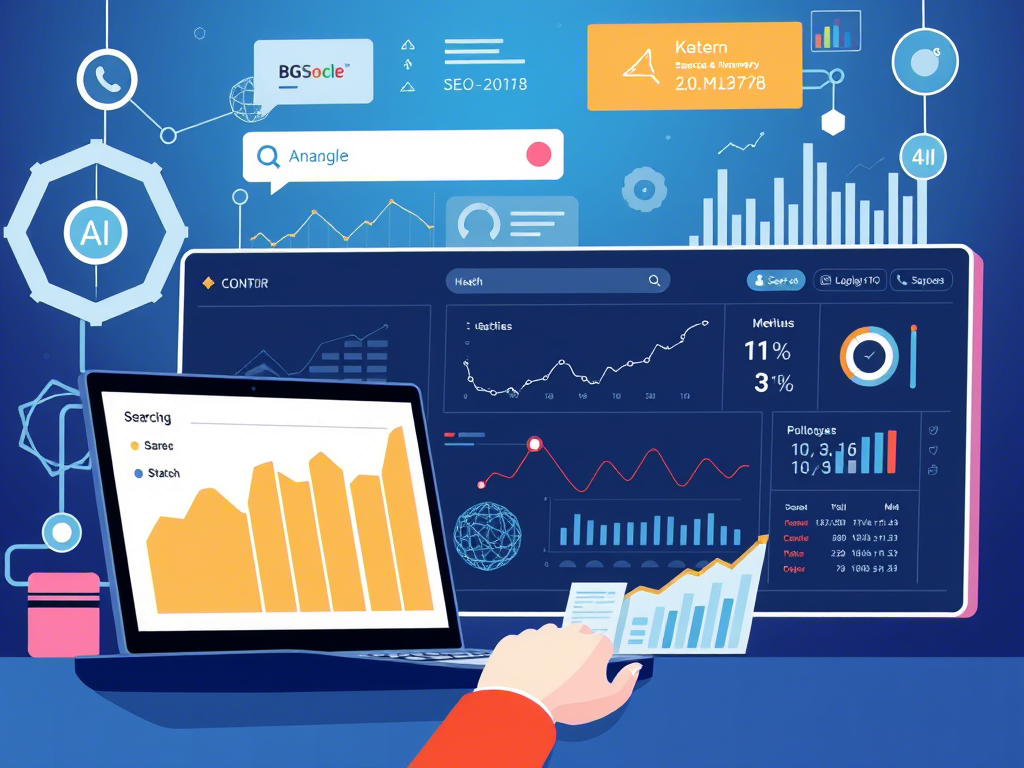Search engine optimization (SEO) has never been anything but being ahead of the curve—but with artificial intelligence (AI) gaining momentum, that curve is accelerating faster than ever before. From smarter keyword research to real-time optimization, AI is no longer on the horizon for SEO. It’s already here, and it’s changing everything.
As search engines like Google rely more on AI to judge intent and return more accurate results, digital marketers must adjust their own strategies to meet that new standard. AI isn’t just making us smarter to work with—it’s enabling us to make more intelligent, data-driven choices previously out of reach or too cumbersome to imitate.
Here, we’ll explore the powerful intersection of AI and SEO—what it looks like today, how it’s already altering digital marketing, and what the future holds for companies. Whether you’re an SEO expert, a content marketing guru, or an owner, understanding how AI fits into the search equation is now a success key.
Understanding AI in the Context of SEO
In order to understand AI’s potential in SEO, we first must get clear on what AI is here—and why it’s a game-changer for search engines and marketers alike.
What is Artificial Intelligence in SEO?
At its simplest, artificial intelligence is the ability of machines to replicate human intelligence—learning from data, recognizing patterns, making decisions, and improving over time. Applied to SEO, AI helps with tasks such as automating, revealing insight, and optimizing strategies by analyzing vast amounts of data far faster than any human possibly could.
AI SEO facilitates things like:
- Natural Language Processing (NLP) for understanding search intent.
- Predictive analytics for predicting keyword trends.
- Machine learning-based ranking algorithm (e.g., Google’s RankBrain and BERT).
- Content optimization and generation tools.
How SEO has changed with AI
SEO was very formulaic at one time—add the keywords, fill out the metadata, and make backlinks. But as search engines have come a long way, so have we. With AI, SEO has entered an era where context, user habits, and semantic understanding are worth more than stuffing keywords or using exact-match words.
And now, AI not only helps marketers perform SEO—it’s built into how search engines work. For example:
- Google RankBrain employs machine learning to assist in better understanding queries and providing appropriate results, especially for ambiguous or long-tail queries.
- BERT and MUM allow Google to understand natural language and nuance of context—making good-quality content more important than ever.
Why It Matters Now
As AI is now integrated into how we optimize and how search engines index, staying up to date requires more than best practices—it requires smart, dynamic SEO strategies. Embracing AI will provide a huge advantage to those who do in ranking, reach, and performance.
Key take-away: AI is not some new SEO trick—it’s a paradigm shift in the way search engines think, rank, and respond. Learning about it is step one; leveraging it successfully is what leaders do.
AI-Powered Keyword Research and Analysis
Keyword analysis was forever the backbone of good SEO—but AI is propelling it into a whole new realm. Instead of just finding high-volume keywords, AI software can now analyze intent, predict trends, spot gaps, and recommend long-tail options with some degree of accuracy and speed that human efforts just can’t match.
1. Intelligent Keyword Discovery
Legacy keyword tools rely on surface-level metrics like search volume and competition. AI goes deeper by analyzing:
- Searcher intent (informational, navigational, transactional).
- Semantic relationships between subjects.
- Individuals are searching on forums, reviews, and social media.
Example: AI can identify that “best cushioned running shoes for knee pain” is a lower-competition, higher-converting keyword according to existing search volume, as opposed to merely suggesting “best running shoes.”
2. Predictive Search Trends
AI tools don’t just inform you of what’s trending—they forecast what will trend.
- They acquire new material, seasonal trends, and algo updates.
- Allow you to create content before your competition.
- Best for planning forward campaigns and content schedules.
Use case: A tech-savvy skincare company detects a surge in “skin cycling” searches weeks before it becomes mainstream—”getting ahead of the curve” through informative blog posts and specialized product pages.
3. Topic Clustering and Intent-Based Grouping
AI can automatically categorize keywords by intent and theme, helping SEOs to develop:
- Content hubs and topic clusters.
- Internal linking strategies.
- Smarter navigation and UX architectures.
This makes your site more useful to both search engines and users.
4. AI-Driven Keyword Tools You Should Know
- Semrush Keyword Magic Tool – Has AI-integrated intent filters.
- Ahrefs and Surfer SEO – Employ AI to semantically group keywords and ranking chances.
- AlsoAsked and AnswerThePublic – Imagine AI-generated question-driven search patterns.
Takeaway: AI is turning keyword research from guessing to strategy. It enables you to know what people are looking for—and why—so that you can build answers that actually rank.

On-Page SEO Optimization with AI
AI is not just revolutionizing the way we research and write content—it’s revolutionizing the way we optimize every element of a webpage in order to rank higher in search. From writing metadata, to optimizing images and internal linking, AI enables marketers to streamline on-page SEO in smarter, more efficient, and more data-driven ways.
1. Smart Meta Titles and Descriptions
Creating engaging, keyword-rich meta titles and descriptions is a task—AI software makes it easy and efficient.
- Create click-worthy metadata for user intent.
- Automatically A/B test headlines in multiple alternatives
- Optimize for best length and search intent match.
Tip tool: You can use tools like Jasper and Writesonic to generate SEO-optimized metadata within seconds from your content and target keywords.
2. Image and Video Optimization
Visual content is worth but can slow down pages or be disregarded by search engines if not properly optimized. AI helps by:
- Automatically creating descriptive alt text with computer vision.
- Compressing images without compromising any quality to improve page speed.
- Video transcribing and tagging to make it more accessible and indexable.
Example: An AI-based solution like Cloudinary resizes images dynamically based on device and user’s connection speed—enhancing load times and UX.
3. Internal Linking Strategy
Strong internal linking improves crawlability, shares link equity, and keeps users on-site longer. AI tools are able to:
- Suggest relevant internal links based on content relationships.
- Orphaned pages (pages with no incoming links) must be identified.
- Map smart content clusters for better topic authority.
Test tool: LinkWhisper uses AI to give you internal link suggestions in WordPress as you write or edit a post.
Key point: On-page SEO is no longer guessing! It’s about accuracy. You can optimize every page element with data-driven decisions to increase visibility, usability, and click-throughs with AI.
Technical SEO and AI Applications
Technical SEO sets the foundation for search engine visibility—and AI is showing itself to be a mighty partner in diagnosing problems, automating audits, and making real-time adjustments that enhance site performance, crawlability, and ranking potential.
1. Site Performance Analysis and Speed Optimization
Page loading and site responsiveness directly affect user experience and SEO rankings. AI is capable of:
- Monitor Core Web Vitals (LCP, CLS, FID) continuously.
- Suggest code-level optimizations like lazy loading, compression, or script deferral.
- Improve delivery by user browser or device for best load times.
Example: Tools like NitroPack or PageSpeed Insights powered by AI and ML-driven recommendations can auto-optimize load performance.
2. Structured Data Implementation
Schema markup makes your content more understandable to search engines—and AI tools make it easier.
- Generate JSON-LD structured data automatically for articles, products, events, etc.
- Identify missing schema components and recommend implementation.
- Provide other chances of acquiring rich outcomes like FAQs, reviews, or sitelinks.
Tip: Leverage tools like Merkle’s Schema Generator or Surfer SEO’s audit tool for schema suggestions and markup created using AI.
3. Crawlability and Indexing Improvements
AI audits detect issues that might block your pages from being crawled or indexed properly:
- Identify broken links, redirect chains, or unreachable resources.
- Identify inconsistencies in sitemaps and crawling depth problems.
- Rank repairs by SEO potential impact.
Tip tool: DeepCrawl and Screaming Frog now offer AI-driven diagnostics that detect complex site structure problems in big-scale configurations.
Main point: AI goes beyond checklists for SEOs—providing smarter, faster, and more actionable intelligence for technical optimization. The result? A faster, healthier, and more crawlable site search engines (and users) adore.
AI in Backlink Analysis and Link Building
Backlinks remain one of the strongest ranking signals in SEO—but it’s time-consuming and sporadic to spot the right opportunities, monitor your profile, and research competition. That’s where AI comes in. With intelligent automation, AI makes link building smarter, faster, and more strategic.
1. Identifying Good Quality Linking Opportunities
Artificial intelligence-based software search through millions of websites for backlink opportunities that align with your niche and goals.
- Evaluate site authority, topicality, and trust factors.
- Eliminate low-quality or spammy sources.
- Forecast which links will deliver SEO worth and referral traffic.
Example: An AI assists a SaaS company to find niche technology blogs with high engagement and domain authority—streamlining outreach to quality leads.
2. Competitor Backlink Analysis
Wondering where your competitors are acquiring links? AI software makes it simple to reverse-engineer effective backlink methods.
- Examine backlink profiles of top-ranking pages.
- Identify shared linking domains.
- Identify content types that are most backlinked.
Tip tool: Ahrefs and SEMrush tools utilize AI to categorize competitor backlink sources and suggest the most promising replication opportunities.
3. Connect Health Monitoring and Maintenance
AI doesn’t stop when the link is live—it helps you monitor and protect your backlink profile.
- Get alerts for missing or broken links.
- Find toxic backlinks and recommend disavow actions.
- Monitor new brand mentions that can turn into links.
Tip: Use tools such as Linkody or Monitor Backlinks to automate link tracking and notify issues before they adversely affect rankings.
Main takeaway: Link building is still all about relationships and relevance—but with AI, you can target the correct targets, reduce manual research, and scale with confidence.
User Experience (UX) and AI-Based SEO
Google’s algorithm is no longer just about keywords and links—it’s about signals of user experience. Marketers can now monitor and optimize UX in real time thanks to AI and build better, more engaging, intuitive, and search-engine-and-people-friendly websites.
1. UX Insights and Behavioral Analysis
AI software tracks and examines the way users use your site and how it can be optimized.
- Monitor click streams, scroll depth, bounce rate, and session length.
- Reveal pain points like sluggish feature loading or confusing navigation.
- Offer UX heatmaps, session replays, and actionable insights.
Tip: Hotjar and Microsoft Clarity use AI to alert you to high-impact UX issues automatically.
2. Personalized On-Site Experiences
AI-powered personalization engines provide real-time content to users according to their behavior and interests.
- Recommend other products, services, or articles.
- Personalize messaging based on visitor location, device, or history.
- Increase engagement and time on site—SEO signals
Example: A content website leverages AI to provide users with personalized content recommendations, decreasing bounce rate by 30% and improving dwell time.
3. Accessibility Enhancements
Google prefers sites that are easily accessible, and your website can be made easily accessible by AI.
- AI-based features detect missing alt text, missing color contrast, or broken ARIA labels.
- Automatically generate alt text for images based on computer vision.
- Suggest navigation improvements for screen reader and keyboard-only users
Tip: Utilize AI-based tools like accessiBe or AudioEye for accessibility compliance (WCAG, ADA) as well as for UX improvement for all.
Koenig’s key takeaway: Good UX = better SEO. With AI, you can learn what users do at scale—and make your site better at serving them, driving engagement and rankings as a byproduct.
Ethical Challenges and Problems
With more incorporation of AI into SEO practice also comes important questions around quality, fairness, and transparency of content. As much as AI offers incredible productivity, marketers must ensure that usage is congruent with ethical best practice—and isn’t degrading trust or search integrity.
1. Originality and Authenticity of Content
AI content will function, but when manipulated, can lead to:
- Poor, thin, or redundant pages.
- Keyword-laden content for rankings only.
- Risk of violating Google’s spam or auto-generated content policy.
Best practice: Always fact-check and edit AI content. Google prefers people-first, helpful content, not quantity content.
2. Algorithmic Bias in SEO Tools
AI programs learn from biased data sets, and this tends to distort results. For instance:
- Prioritizing specific industries or content types in keyword suggestions.
- Proposing archaic or discriminatory terms.
- Tagging relevant content due to skewed training data.
Tip: Use human judgment supplemented by AI insights to avoid overreliance on flawed automation.
3. Trust and Transparency
If you’re using artificial intelligence to generate content or make SEO decisions, how much do humans—and Google—have to know?
- Disclose AI-generated content if needed.
- Exert editorial control to ensure quality and accuracy.
- Refrain from employing AI to cheat rankings through deceptive strategies.
Ethical aside: Google’s March 2024 guidelines remind us that AI content is okay—provided it’s helpful, unique, and follows E-E-A-T standards (Experience, Expertise, Authoritativeness, Trustworthiness).
Takeaway: AI is an effective SEO tool, but use it responsibly. Ethical use creates a sense of trust with users and search engines alike—while short-term shortcuts are likely to lead to long-term penalties.
Future Trends in AI and SEO
As search engines and AI become increasingly smarter, we’re entering a new era of SEO—one that’s characterized by learning in real time, intent-based results, and hyper-personalization. To stay ahead is to look ahead. Here’s what’s on the horizon for digital marketers in the near term.
1. Voice Search and Conversational AI
According to the emergence of voice assistants like Siri, Alexa, and Google Assistant, voice search optimization has become the norm.
- Questions are becoming longer, more chatty, and goal-oriented.
- AI will help brands structure content into patterns that are in line with spoken search habits.
- Search for more emphasis on question-based keywords, featured snippets, and local optimization.
Do: Use natural language first, FAQs second, and short answers to voice-friendly questions last.
2. Multimodal SEO and Visual Search
Computer vision-based visual search (e.g., Google Lens, Pinterest Lens) is making images searchable like never before.
- People are now able to search with pictures instead of text.
- Image context, filename, and alt text will matter more in terms of rankings.
- SEO will be expanded to include image quality, relevance, and visual recognition.
Alert: Prep your product pics, infographics, and brand visuals for AI indexing.
3. Real-Time Content Adaptation
AI will enable sites to customize content in the moment to behavior and context of the user.
- Dynamically, page layouts, CTAs, or headings can be changed.
- SEO will shift from static optimization to experience-based ranking.
- Search engines can start to favor sites that show adaptive, user-focused experiences.
Example: A travel website shows a different set of things to a returning user versus a new one—each equally optimized for their behavior.
Main point: The future of SEO is AI. It’s not a question of being more ranked—it’s a question of creating smarter, faster, and more intuitive experiences that align with how people search today—and how they’ll search tomorrow.
Conclusion
AI is not only maximizing SEO—it is maximizing SEO from the get-go. From smarter keyword research and content optimization to real-time UX testing and predictive link building, AI enables marketers to make faster, more educated decisions that not only keep pace with search engine algorithms but with user expectations as well.
This shift is not a substitution of humans—it’s an extension of strategy, velocity, and scope. SEO experts who are utilizing AI will be able to anticipate search behavior, personalize content at scale, and optimize their sites with a level of accuracy that even human capabilities cannot match.
Final consideration: As search engines get smart with AI, we need to get smarter too. The future of SEO is in the hands of those capable of blending creative thinking with smart automation—keeping users first and leveraging data-driven tools to get noticed, rank higher, and scale their business quicker.


